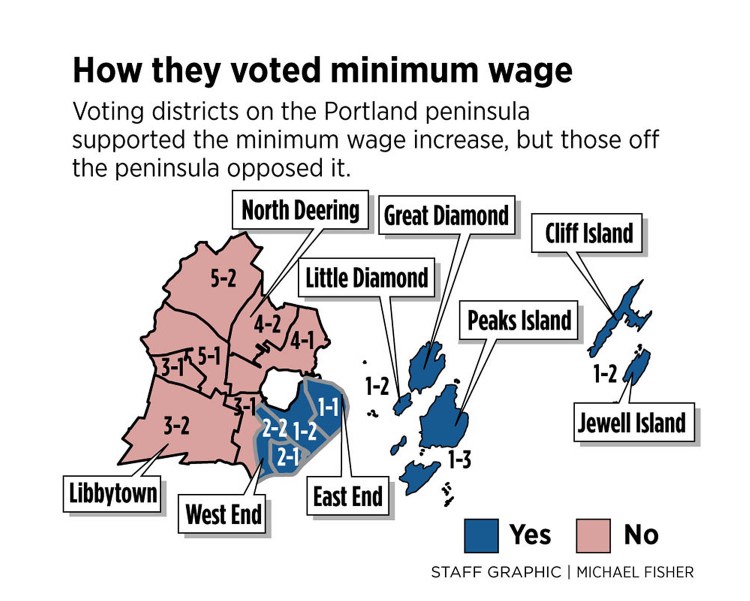The proposal to raise Portland’s minimum wage to $15 an hour won majority support among voters on the city’s peninsula, but it went down to defeat at the hands of off-peninsula residents, who strongly opposed the measure in several large precincts.
The results re-enforce the notion of two Portlands: the more progressive peninsula and the more conservative neighborhoods off peninsula. While the peninsula receives most of the attention of policy makers and tourists because of its working waterfront and historic Old Port, it generally has less influence at the ballot box than the city’s other areas, which have more residents.
The minimum wage proposal, which appeared as Question 1 on the ballot, was decisively rejected by 58 percent of voters citywide.
However, it was supported by 52 percent of voters in Districts 1 and 2, the city’s East and West ends on the peninsula, where many younger people and service workers tend to live. In contrast, it was opposed by 66 percent of off-peninsula residents in Districts 3, 4 and 5, including such neighborhoods as North Deering, Riverton and Stroudwater.
Opposition ran especially high, for example, in District 3, Precinct 2 in Libbytown, where the tally was 679 in favor and 1,217 opposed; and in District 5, Precinct 2 in North Deering, where 532 were in favor and 1,515 were opposed. Those figures eclipsed support for the minimum wage question in places like the West End, where the two precincts in District 2 voted 1,707 in favor and 1,536 opposed.
According to data provided by the city, there are about 20,000 registered voters in Districts 1 and 2, which cover the peninsula plus the islands and a small area near the University of Southern Maine. Off-peninsula, there are roughly 29,000 voters, many of whom are older and more conservative than their counterparts on the peninsula.
Not only are there more voters off peninsula, they also turned out to vote at a higher rate. More than 10,600 ballots were cast off peninsula, putting voter turnout at 37 percent, compared to the 6,400 cast on peninsula, about 32 percent. Citywide, voter turnout was about 35 percent.
NO MAJORITIES FOR QUESTION 2
Question 2, which would have set up a process for preserving scenic views, proved to be deeply unpopular citywide, with 63 percent of voters opposing it.
It was even opposed by voters in Districts 1 and 2, which could have benefited from the proposal. The first view proposed for protection, at 58 Fore St., was in District 1 along the eastern waterfront on Munjoy Hill. Fifty-seven percent of District 1 voters cast ballots against the measure. The opposition grew the further the polling station was from the East End, with 70 percent of District 5 residents in North Deering casting “no” ballots.
STRIMLING WINS 11 OF 12 PRECINCTS
In the mayoral race, Ethan Strimling prevailed in 11 of the city’s 12 voting precincts to defeat incumbent Michael Brennan.
The peninsula showed its progressive colors by giving Tom MacMillan, a Green Independent whose policies were more liberal than his opponents, 14 percent of the vote, compared to the 8 percent he received elsewhere. Brennan also put in a strong on-peninsula showing, earning 41 percent of the vote and winning a precinct – by 46 votes – that includes the Parkside neighborhood, which is home to many immigrants and refugees who could have lost emergency assistance were it not for the incumbent.
Strimling took 45 percent of the peninsula vote, but won 54 percent of the off-peninsula vote, putting him above 50 percent and avoiding an instant runoff election.
Send questions/comments to the editors.




Success. Please wait for the page to reload. If the page does not reload within 5 seconds, please refresh the page.
Enter your email and password to access comments.
Hi, to comment on stories you must . This profile is in addition to your subscription and website login.
Already have a commenting profile? .
Invalid username/password.
Please check your email to confirm and complete your registration.
Only subscribers are eligible to post comments. Please subscribe or login first for digital access. Here’s why.
Use the form below to reset your password. When you've submitted your account email, we will send an email with a reset code.